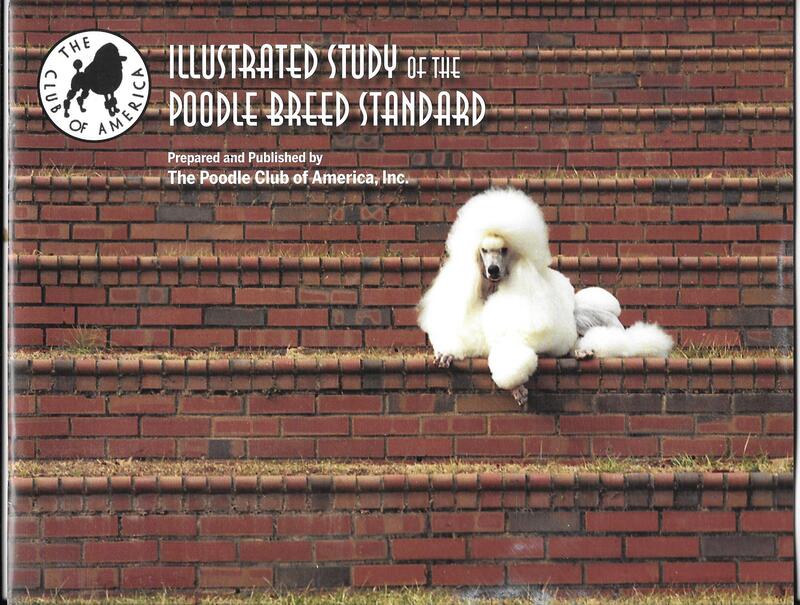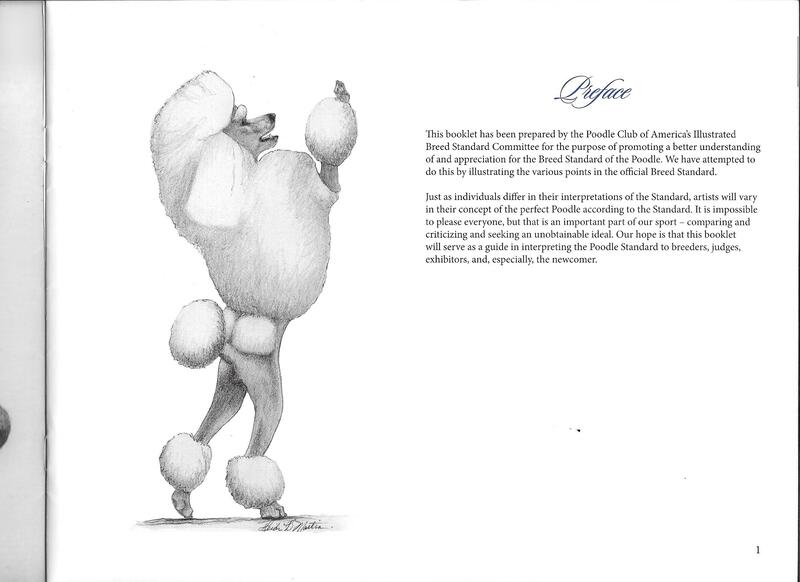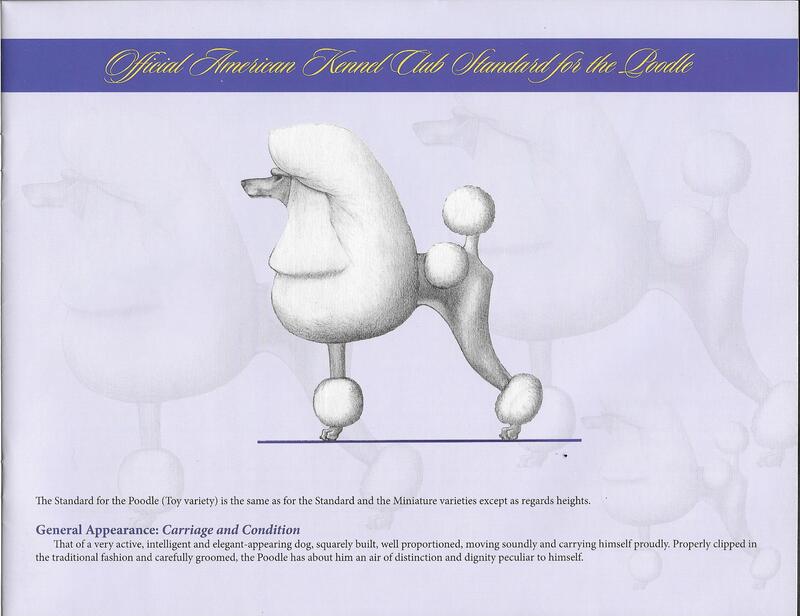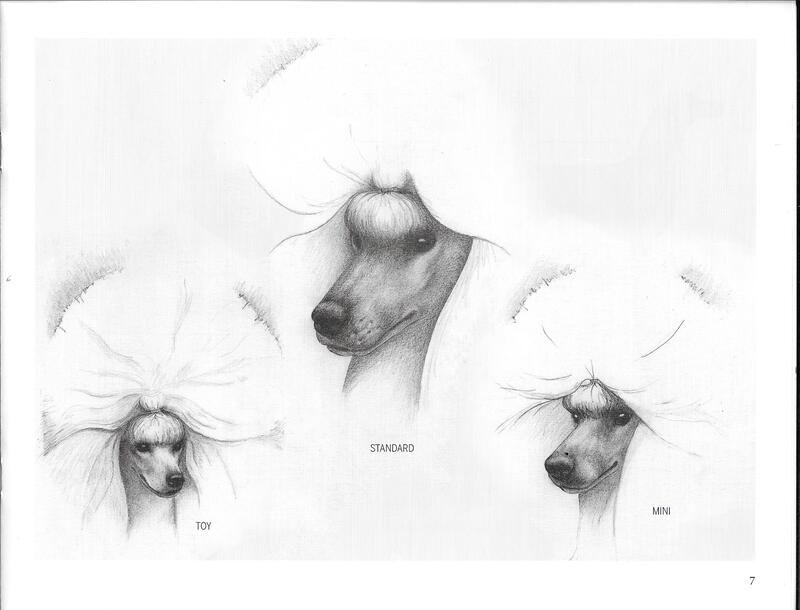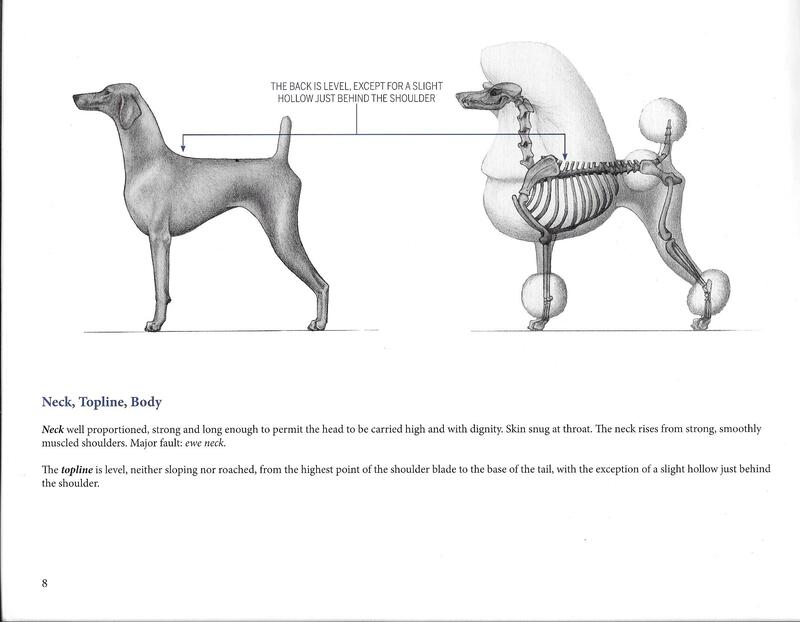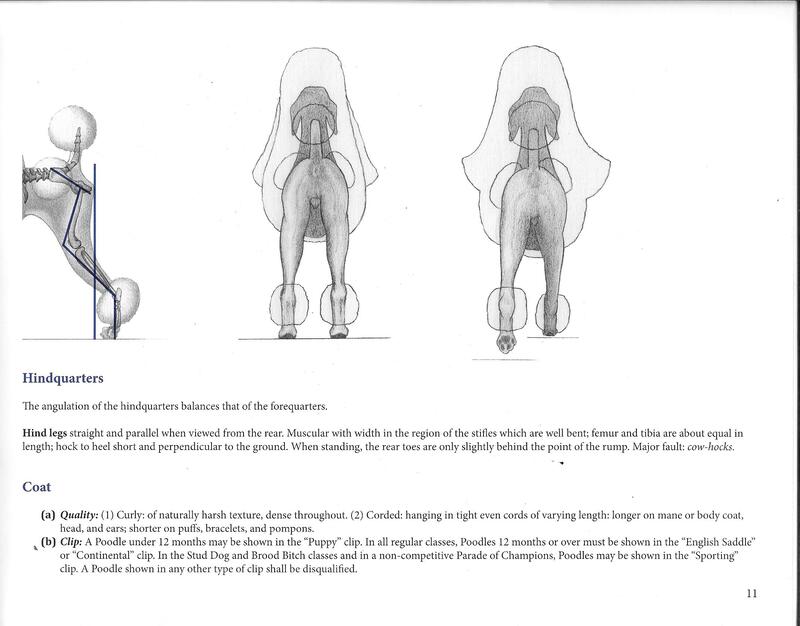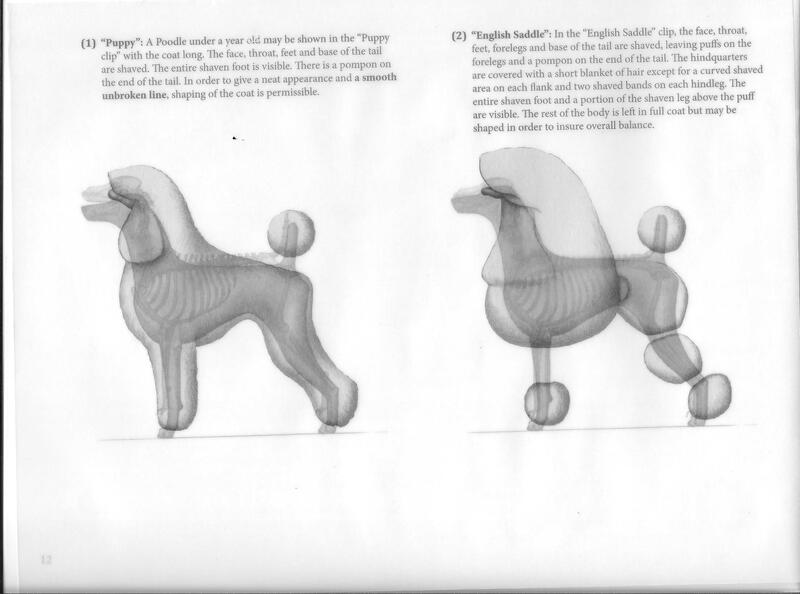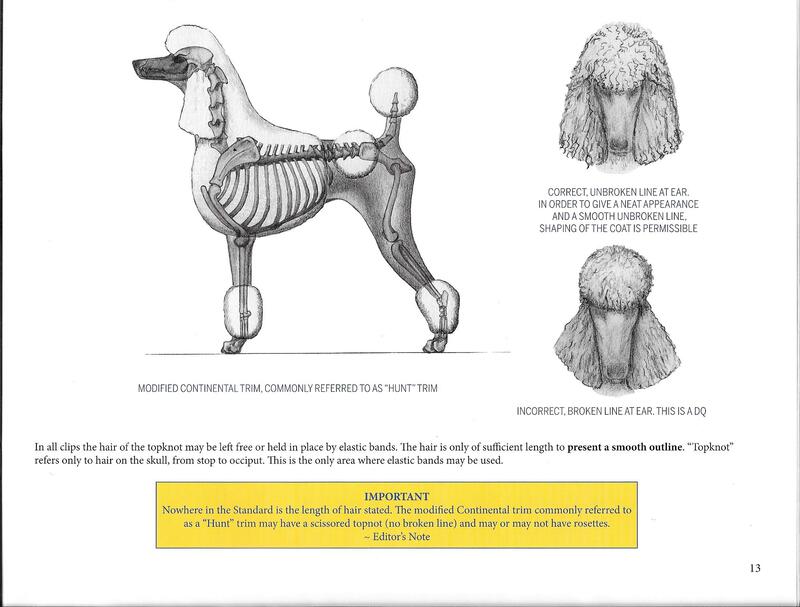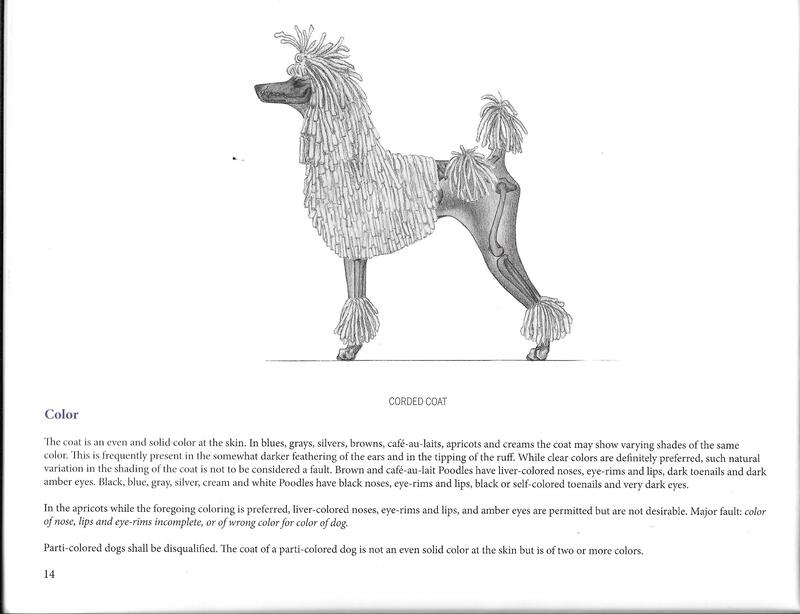
About the Poodle / Breed Standard
American Kennel Club, Non-Sporting/Toy Group
Approved August 14, 1984 - Reformatted March 27, 1990
Source "The AKC Complete Dog"
https://images.akc.org/pdf/breeds/standards/Poodle.pdf
The Standard for the Poodle (Toy variety) is the same as for the Standard and Miniature varieties except as regards to height.
History
The Poodle is supposed to have originated in Germany, where it is known as the Pudel or Canis Familiaris Aquatius. However, for years it has been regarded as the national dog of France, where is was commonly used as a retriever as well as, the Caniche, which is derived from chien canard or duck dog. Doubtless the English word "poodle" comes from the German pudel or pudelin, meaning to splash in the water.
Authorities concede that the large, or Standard, Poodle is the oldest of the three varieties, and that the dog gained special fame as a water worker. So widely was it used as retriever that it was shorn of portions of its coat to further facilitate progress in swimming. Thence came the custom of clipping to pattern which so enhanced the style and general appearance that its sponsors, particularly in France, were captivated by it. All of the Poodle's ancestors were acknowledged to be good swimmers, although one member of the family, the truffle dog (it may have been of Toy or Miniature size), it is said, never went near the water. Truffle hunting was widely practiced in England, and later in Spain and Germany, where the edible fungus has always been considered a delicacy. For scenting and digging up the fungus, the smaller dogs were favored, since they did less damage to the truffles with their feet than the larger kinds. So it is rumored that a terrier was crossed with the Poodle to produce the ideal truffle hunter.
Despite the Standard Poodle's claim to greater age than the other varieties, there is some evidence to show that the smaller types developed only a short time after the breed assumed the general type by which it is recognized today. The smallest, or Toy variety, was known in England in the 18th Century, when the White Cuban became popular there. This was a sleeve dog attributed to the West Indies from whence it traveled to Spain and then to England. But the Continent had known the Poodle long before it came to England. Drawings by the German artist, Albrecht Durer, establish the breed in the 15th and 16th centuries. It was the principal pet dog of the latter 18th century in Spain, as shown by the paintings of the Spanish artist, Goya. And France had Toy Poodles as pampered favorites during the reign of Louis XVI at about the same period.
General Appearance, Carriage and Condition
That of a very active, intelligent and elegant-appearing dog, squarely built, well proportioned, moving soundly and carrying himself proudly. Properly clipped in the traditional fashion and carefully groomed, the Poodle has about him an air of distinction and dignity peculiar to himself.
Size: The Standard Poodle is over 15 inches at the highest point of the shoulders. Any Poodle which is 15 inches or less in height shall be disqualified from competition as a Standard Poodle.
The Miniature Poodle is 15 inches or under at the highest point of the shoulders, with a minimum height in excess of 10 inches. Any Poodle which is over 15 inches or is 10 inches or less at the highest point of the shoulders shall be disqualified from competition as a Miniature Poodle.
The Toy Poodle is 10 inches or under at the highest point of the shoulders. Any Poodle which is more than 10 inches at the highest point of the shoulders shall be disqualified from competition as a Toy Poodle.
As long as the Toy Poodle is definitely a Toy Poodle, and the Miniature Poodle a Miniature Poodle, both in balance and proportion for the Variety, diminutiveness shall be the deciding factor when all other points are equal.
Proportion: To insure the desirable squarely built appearance, the length of body measured from the breastbone to the point of the rump approximates the height from the highest point of the shoulders to the ground.
Substance: Bone and muscle of both forelegs and hindlegs are in proportion to size of dog.
Head and Expression
(a) Eyes, very dark, oval in shape and set far enough apart and positioned to create an alert intelligent expression. Major fault: eyes round, protruding, large or very light.
(b) Ears, hanging close to the head, set at or slightly below eye level. The ear leather is long, wide and thickly feathered; however, the ear fringe should not be of excessive length.
(c) Skull, moderately rounded, with a slight but definite stop. Cheekbones and muscles flat. Length from occiput to stop about the same as length of muzzle.
(d) Muzzle, long, straight and fine, with slight chiseling under the eyes. Strong without lippiness. The chin definite enough to preclude snipiness. Major fault: lack of chin.
(e) Teeth, white, strong and with a scissors bite. Major fault: undershot, overshot, wry mouth.
Neck well proportioned, strong and long enough to permit the head to be carried high and with dignity. Skin snug at throat. The neck rises from strong, smoothly muscled shoulders. Major fault: ewe neck.
The topline is level, neither sloping nor roached, from the highest point of the shoulder blade to the base of the tail, with the exception of a slight hollow just behind the shoulder.
Body
(a) Chest deep and moderately wide with well sprung ribs.
(b) The loin is short, broad and muscular.
(c) Tail straight, set on high and carried up, docked of sufficient length to insure a balanced outline. Major fault: set low, curled, or carried over the back.
Forequarters - Strong, smoothly muscled shoulders. The shoulder blade is well laid back and approximately the same length as the upper foreleg. Major fault: steep shoulder.
(a) Forelegs - Straight and parallel when viewed from the front. When viewed from the side the elbow is directly below the highest point of the shoulder. The pasterns are strong. Dewclaws may be removed.
Feet - The feet are rather small, oval in shape with toes well arched and cushioned on thick firm pads. Nails short but not excessively shortened. The feet turn neither in nor out. Major fault: paper or splay foot.
Hindquarters - The angulation of the hindquarters balances that of the forequarters.
(a) Hind legs straight and parallel when viewed from the rear. Muscular with width in the region of the stifles which are well bent; femur and tibia are about equal in length; hock to heel short and perpendicular to the ground. When standing, the rear toes are only slightly behind the point of the rump. Major fault: cow-hocks.
Coat
(a) Quality
(1) Curly: of naturally harsh texture, dense throughout.
(2) Corded: hanging in tight even cords of varying length; longer on mane or body coat, head, and ears; shorter on puffs, bracelets, and pompons.
(b) Clip: A Poodle under 12 months may be shown in the "Puppy" clip. In all regular classes, Poodles 12 months or over must be shown in the "English Saddle" or "Continental" clip. In the Stud Dog and Brood Bitch classes and in a non-competitive Parade of Champions, Poodles may be shown in the "Sporting" clip.
A Poodle shown in any other type of clip shall be disqualified.
(1) "Puppy" A Poodle under a year old may be shown in the "Puppy" clip with the coat long. The face, throat, feet and base of the tail are shaved. The entire shaven foot is visible. There is a pompon on the end of the tail. In order to give a neat appearance and a smooth unbroken line, shaping of the coat is permissible.
(2) "English Saddle" In the "English Saddle" clip the face, throat, feet, forelegs and base of the tail are shaved, leaving puffs on the forelegs and a pompon on the end of the tail. The hindquarters are covered with a short blanket of hair except for a curved shaved area on each flank and two shaved bands on each hindleg. The entire shaven foot and a portion of the shaven leg above the puff are visible. The rest of the body is left in full coat but may be shaped in order to insure overall balance.
(3) "Continental" In the "Continental" clip, the face, throat, feet, and base of the tail are shaved. The hindquarters are shaved with pompons (optional) on the hips. The legs are shaved, leaving bracelets on the hindlegs and puffs on the forelegs. There is a pompon on the end of the tail. The entire shaven foot and a portion of the shaven foreleg above the puff are visible. The rest of the body is left in full coat but may be shaped in order to insure overall balance.
(4) "Sporting" In the "Sporting" clip, a Poodle shall be shown with face, feet, throat, and base of tail shaved, leaving a scissored cap on the top of the head and a pompon on the end of the tail. The rest of the body, and legs are clipped or scissored to follow the outline of the dog leaving a short blanket of coat no longer than one inch in length. The hair on the legs may be slightly longer than that on the body.
In all clips the hair of the topknot may be left free or held in place by elastic bands. The hair is only of sufficient length to present a smooth outline. "Topknot" refers only to hair on the skull, from stop to occiput. This is the only area where elastic bands may be used.
Color - The coat is an even and solid color at the skin. In blues, grays, silvers, browns, cafe-au-laits, apricots and creams the coat may show varying shades of the same color. This is frequently present in the somewhat darker feathering of the ears and in the tipping of the ruff. While clear colors are definitely preferred, such natural variation in the shading of the coat is not to be considered a fault. Brown and cafe-au-lait Poodles have liver-colored noses, eye-rims and lips, dark toenails and dark amber eyes. Black, blue, gray, silver, cream and white Poodles have black noses, eye-rims and lips, black or self colored toenails and very dark eyes. In the apricots while the foregoing coloring is preferred, liver-colored noses, eye-rims and lips, and amber eyes are permitted but are not desirable. Major fault: color of nose, lips and eye-rims incomplete, or of wrong color for color of dog.
https://images.akc.org/pdf/breeds/standards/Poodle.pdf
(Parti-colored dogs shall be disqualified. The coat of a parti-colored dog is not an even solid color at the skin but is of two or more colors)
Gait - A straightforward trot with light springy action and strong hindquarters drive. Head and tail carried up. Sound effortless movement is essential.
Temperament - Carrying himself proudly, very active, intelligent, the Poodle has about him an air of distinction and dignity peculiar to himself. Major fault: shyness or sharpness.
Major Faults are any distinct deviation from the desired characteristics described in the Breed Standard.
Disqualifications Size: A dog over or under the height limits specified shall be disqualified.
Clip: A dog in any type of clip other than those listed under coat shall be disqualified.
Parti-colors: The coat of a parti-colored dog is not an even solid color at the skin but of two or more colors. Parti-colored dogs shall be disqualified.
Value of Points = 100
Appearance, temperament, carriage & condition 30
Head, expression, ears, eyes & teeth 20
Body, neck, legs, feet & tail 20
Gait 20
Coat, color & texture 10
American Kennel Club, Non-Sporting/Toy Group
Approved August 14, 1984 - Reformatted March 27, 1990
Source "The AKC Complete Dog"
https://images.akc.org/pdf/breeds/standards/Poodle.pdf
The Standard for the Poodle (Toy variety) is the same as for the Standard and Miniature varieties except as regards to height.
History
The Poodle is supposed to have originated in Germany, where it is known as the Pudel or Canis Familiaris Aquatius. However, for years it has been regarded as the national dog of France, where is was commonly used as a retriever as well as, the Caniche, which is derived from chien canard or duck dog. Doubtless the English word "poodle" comes from the German pudel or pudelin, meaning to splash in the water.
Authorities concede that the large, or Standard, Poodle is the oldest of the three varieties, and that the dog gained special fame as a water worker. So widely was it used as retriever that it was shorn of portions of its coat to further facilitate progress in swimming. Thence came the custom of clipping to pattern which so enhanced the style and general appearance that its sponsors, particularly in France, were captivated by it. All of the Poodle's ancestors were acknowledged to be good swimmers, although one member of the family, the truffle dog (it may have been of Toy or Miniature size), it is said, never went near the water. Truffle hunting was widely practiced in England, and later in Spain and Germany, where the edible fungus has always been considered a delicacy. For scenting and digging up the fungus, the smaller dogs were favored, since they did less damage to the truffles with their feet than the larger kinds. So it is rumored that a terrier was crossed with the Poodle to produce the ideal truffle hunter.
Despite the Standard Poodle's claim to greater age than the other varieties, there is some evidence to show that the smaller types developed only a short time after the breed assumed the general type by which it is recognized today. The smallest, or Toy variety, was known in England in the 18th Century, when the White Cuban became popular there. This was a sleeve dog attributed to the West Indies from whence it traveled to Spain and then to England. But the Continent had known the Poodle long before it came to England. Drawings by the German artist, Albrecht Durer, establish the breed in the 15th and 16th centuries. It was the principal pet dog of the latter 18th century in Spain, as shown by the paintings of the Spanish artist, Goya. And France had Toy Poodles as pampered favorites during the reign of Louis XVI at about the same period.
General Appearance, Carriage and Condition
That of a very active, intelligent and elegant-appearing dog, squarely built, well proportioned, moving soundly and carrying himself proudly. Properly clipped in the traditional fashion and carefully groomed, the Poodle has about him an air of distinction and dignity peculiar to himself.
Size: The Standard Poodle is over 15 inches at the highest point of the shoulders. Any Poodle which is 15 inches or less in height shall be disqualified from competition as a Standard Poodle.
The Miniature Poodle is 15 inches or under at the highest point of the shoulders, with a minimum height in excess of 10 inches. Any Poodle which is over 15 inches or is 10 inches or less at the highest point of the shoulders shall be disqualified from competition as a Miniature Poodle.
The Toy Poodle is 10 inches or under at the highest point of the shoulders. Any Poodle which is more than 10 inches at the highest point of the shoulders shall be disqualified from competition as a Toy Poodle.
As long as the Toy Poodle is definitely a Toy Poodle, and the Miniature Poodle a Miniature Poodle, both in balance and proportion for the Variety, diminutiveness shall be the deciding factor when all other points are equal.
Proportion: To insure the desirable squarely built appearance, the length of body measured from the breastbone to the point of the rump approximates the height from the highest point of the shoulders to the ground.
Substance: Bone and muscle of both forelegs and hindlegs are in proportion to size of dog.
Head and Expression
(a) Eyes, very dark, oval in shape and set far enough apart and positioned to create an alert intelligent expression. Major fault: eyes round, protruding, large or very light.
(b) Ears, hanging close to the head, set at or slightly below eye level. The ear leather is long, wide and thickly feathered; however, the ear fringe should not be of excessive length.
(c) Skull, moderately rounded, with a slight but definite stop. Cheekbones and muscles flat. Length from occiput to stop about the same as length of muzzle.
(d) Muzzle, long, straight and fine, with slight chiseling under the eyes. Strong without lippiness. The chin definite enough to preclude snipiness. Major fault: lack of chin.
(e) Teeth, white, strong and with a scissors bite. Major fault: undershot, overshot, wry mouth.
Neck well proportioned, strong and long enough to permit the head to be carried high and with dignity. Skin snug at throat. The neck rises from strong, smoothly muscled shoulders. Major fault: ewe neck.
The topline is level, neither sloping nor roached, from the highest point of the shoulder blade to the base of the tail, with the exception of a slight hollow just behind the shoulder.
Body
(a) Chest deep and moderately wide with well sprung ribs.
(b) The loin is short, broad and muscular.
(c) Tail straight, set on high and carried up, docked of sufficient length to insure a balanced outline. Major fault: set low, curled, or carried over the back.
Forequarters - Strong, smoothly muscled shoulders. The shoulder blade is well laid back and approximately the same length as the upper foreleg. Major fault: steep shoulder.
(a) Forelegs - Straight and parallel when viewed from the front. When viewed from the side the elbow is directly below the highest point of the shoulder. The pasterns are strong. Dewclaws may be removed.
Feet - The feet are rather small, oval in shape with toes well arched and cushioned on thick firm pads. Nails short but not excessively shortened. The feet turn neither in nor out. Major fault: paper or splay foot.
Hindquarters - The angulation of the hindquarters balances that of the forequarters.
(a) Hind legs straight and parallel when viewed from the rear. Muscular with width in the region of the stifles which are well bent; femur and tibia are about equal in length; hock to heel short and perpendicular to the ground. When standing, the rear toes are only slightly behind the point of the rump. Major fault: cow-hocks.
Coat
(a) Quality
(1) Curly: of naturally harsh texture, dense throughout.
(2) Corded: hanging in tight even cords of varying length; longer on mane or body coat, head, and ears; shorter on puffs, bracelets, and pompons.
(b) Clip: A Poodle under 12 months may be shown in the "Puppy" clip. In all regular classes, Poodles 12 months or over must be shown in the "English Saddle" or "Continental" clip. In the Stud Dog and Brood Bitch classes and in a non-competitive Parade of Champions, Poodles may be shown in the "Sporting" clip.
A Poodle shown in any other type of clip shall be disqualified.
(1) "Puppy" A Poodle under a year old may be shown in the "Puppy" clip with the coat long. The face, throat, feet and base of the tail are shaved. The entire shaven foot is visible. There is a pompon on the end of the tail. In order to give a neat appearance and a smooth unbroken line, shaping of the coat is permissible.
(2) "English Saddle" In the "English Saddle" clip the face, throat, feet, forelegs and base of the tail are shaved, leaving puffs on the forelegs and a pompon on the end of the tail. The hindquarters are covered with a short blanket of hair except for a curved shaved area on each flank and two shaved bands on each hindleg. The entire shaven foot and a portion of the shaven leg above the puff are visible. The rest of the body is left in full coat but may be shaped in order to insure overall balance.
(3) "Continental" In the "Continental" clip, the face, throat, feet, and base of the tail are shaved. The hindquarters are shaved with pompons (optional) on the hips. The legs are shaved, leaving bracelets on the hindlegs and puffs on the forelegs. There is a pompon on the end of the tail. The entire shaven foot and a portion of the shaven foreleg above the puff are visible. The rest of the body is left in full coat but may be shaped in order to insure overall balance.
(4) "Sporting" In the "Sporting" clip, a Poodle shall be shown with face, feet, throat, and base of tail shaved, leaving a scissored cap on the top of the head and a pompon on the end of the tail. The rest of the body, and legs are clipped or scissored to follow the outline of the dog leaving a short blanket of coat no longer than one inch in length. The hair on the legs may be slightly longer than that on the body.
In all clips the hair of the topknot may be left free or held in place by elastic bands. The hair is only of sufficient length to present a smooth outline. "Topknot" refers only to hair on the skull, from stop to occiput. This is the only area where elastic bands may be used.
Color - The coat is an even and solid color at the skin. In blues, grays, silvers, browns, cafe-au-laits, apricots and creams the coat may show varying shades of the same color. This is frequently present in the somewhat darker feathering of the ears and in the tipping of the ruff. While clear colors are definitely preferred, such natural variation in the shading of the coat is not to be considered a fault. Brown and cafe-au-lait Poodles have liver-colored noses, eye-rims and lips, dark toenails and dark amber eyes. Black, blue, gray, silver, cream and white Poodles have black noses, eye-rims and lips, black or self colored toenails and very dark eyes. In the apricots while the foregoing coloring is preferred, liver-colored noses, eye-rims and lips, and amber eyes are permitted but are not desirable. Major fault: color of nose, lips and eye-rims incomplete, or of wrong color for color of dog.
https://images.akc.org/pdf/breeds/standards/Poodle.pdf
(Parti-colored dogs shall be disqualified. The coat of a parti-colored dog is not an even solid color at the skin but is of two or more colors)
Gait - A straightforward trot with light springy action and strong hindquarters drive. Head and tail carried up. Sound effortless movement is essential.
Temperament - Carrying himself proudly, very active, intelligent, the Poodle has about him an air of distinction and dignity peculiar to himself. Major fault: shyness or sharpness.
Major Faults are any distinct deviation from the desired characteristics described in the Breed Standard.
Disqualifications Size: A dog over or under the height limits specified shall be disqualified.
Clip: A dog in any type of clip other than those listed under coat shall be disqualified.
Parti-colors: The coat of a parti-colored dog is not an even solid color at the skin but of two or more colors. Parti-colored dogs shall be disqualified.
Value of Points = 100
Appearance, temperament, carriage & condition 30
Head, expression, ears, eyes & teeth 20
Body, neck, legs, feet & tail 20
Gait 20
Coat, color & texture 10
